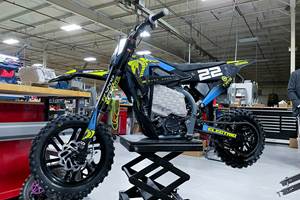3D Systems’ ProJet MJP 2500W Plus Printer for Improved Jewelry Production
The printer is designed to enable the quick and cost-effective creation, iteration and production of all jewelry styles, including the most complex geometries.
High resolution 100% wax casting patterns in hours for custom and high-volume jewelry manufacturing. Photo Credit: 3D Systems
3D Systems’ ProJet MJP 2500W Plus printer for additive manufacturing (AM) is designed to produce complex, high-quality, pure wax 3D printed jewelry patterns with unparalleled speed and precision for use in the lost wax casting process. The printer is engineered specifically to meet the unique requirements of the jewelry industry, capable of producing high-resolution 100% wax casting patterns in hours.
Additionally, it is said the high-resolution printing mode enables best-in-class smooth pure wax casting patterns that require less finishing to reduce precious metal waste. This enables the quick and cost-effective creation, iteration and production of all jewelry styles, including the most complex geometries.
The requirement for manual polishing can present a significant strain on resources — both on talent and materials — which can negatively impact profitability. To overcome this challenge, the ProJet MJP 2500W Plus 3D printer includes a ZHD print mode which delivers up to 2 times improvement in vertical resolution, without an increase in wax material consumption. The resulting high-quality surface finish reduces the need for manual polishing of final parts, thereby minimizing gold loss which, in turn, can positively impact profitability. Additionally, with a reduced need for polishing, customers can produce increasingly complex designs for which polishing is not practical.
Meeting both demand and high quality standards requires fast design iteration and customization, and the ability to deliver high-volume production batches. The printer is engineered to help customers increase throughput by up to 25% compared to many other available solutions. With higher productivity for the printer, customers can realize faster time to parts-in-hand, and more flexibility in planning builds. When used as part of 3D Systems’ comprehensive MultiJet Printing solution for jewelry casting comprising the ProJet MJP 2500W Plus, VisiJet wax materials and 3D Sprint software, customers are able to quickly and consistently generate microdetail, precision, 100% wax sacrificial casting patterns for high-capacity jewelry production.
The printer prints in VisiJet 100% wax materials to print true-to-CAD and fine feature definition jewelry patterns with exact, razor-sharp edges and extremely crisp details. VisiJet wax melts like standard casting waxes, with zero ash content for defect-free castings. It is durable for handling and casting fine features, and high contrast colors enable easy fine detail visualization. Additionally, 3D Systems’ advanced 3D Sprint software capabilities enable users to streamline their file-to-pattern workflow.
“This innovation allows our customers to deliver exceptional design styles, while reducing pattern production time and operational costs, meeting the demands of a mass-customization environment,” says Scott Anderson, vice president, segment leader, 3D Systems. “Coupled with the reliable and repeatable direct casting of our 100% wax solution, users will be able to achieve cost-effective, high-quality casting patterns with quick turnaround and high throughput.”
- Read this article as the AM Team lists 10 important developments in additive manufacturing seen at Formnext 2022, including 3D Systems’ redesign for the frame and structure of its machines. One big change: The mechanics of the machine have been moved to the side so the back of the machine can be opened for robot access.
- Read this post about 3D Systems helping TE Connectivity to additively manufacture electrical connectors using a newly developed photopolymer 3D Systems engineered specifically to meet TE Connectivity’s requirements.
- Learn about the materials 3D Systems developed which are are production-grade materials designed to address a breadth of industrial applications.
Related Content
New Electric Dirt Bike Is Designed for Molding, but Produced Through 3D Printing (Includes Video)
Cobra Moto’s new all-electric youth motocross bike could not wait for mold tooling. Parts have been designed so they can be molded eventually, but to get the bike to market, the production method now is additive manufacturing.
Read MoreAdditive Manufacturing Is Subtractive, Too: How CNC Machining Integrates With AM (Includes Video)
For Keselowski Advanced Manufacturing, succeeding with laser powder bed fusion as a production process means developing a machine shop that is responsive to, and moves at the pacing of, metal 3D printing.
Read MoreHow to Build 10,000+ Shot Molds in Hours
Rapid tooling isn’t so rapid when it takes days to 3D print a metal mold, and then you still must machine it to reach the necessary tolerances. With Nexa3D’s polymer process you can print a mold in hours that is prototype or production ready and can last for more than 10,000 shots.
Read MoreWhat Does Additive Manufacturing Readiness Look Like?
The promise of distributed manufacturing is alluring, but to get there AM first needs to master scale production. GKN Additive’s Michigan facility illustrates what the journey might look like.
Read MoreRead Next
At General Atomics, Do Unmanned Aerial Systems Reveal the Future of Aircraft Manufacturing?
The maker of the Predator and SkyGuardian remote aircraft can implement additive manufacturing more rapidly and widely than the makers of other types of planes. The role of 3D printing in current and future UAS components hints at how far AM can go to save cost and time in aircraft production and design.
Read More3D Printing Brings Sustainability, Accessibility to Glass Manufacturing
Australian startup Maple Glass Printing has developed a process for extruding glass into artwork, lab implements and architectural elements. Along the way, the company has also found more efficient ways of recycling this material.
Read MoreHybrid Additive Manufacturing Machine Tools Continue to Make Gains (Includes Video)
The hybrid machine tool is an idea that continues to advance. Two important developments of recent years expand the possibilities for this platform.
Read More












.png;maxWidth=300;quality=90)











